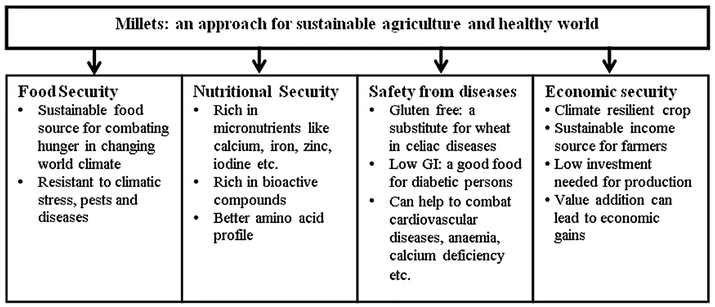Agriculture
Millets: Superfood
This article is based on “Healthy And Wise” which was published in The Indian Express on 23/10/2020. It talks about the importance of millets in securing Food, Nutritional and Economic Security.
Millets are often referred to as Superfood and its production can be seen as an approach for sustainable agriculture and a healthy world. Multidimensional benefits associated with millets can address the issues related to nutrition security, food systems security, and farmers’ welfare.
Further, many unique features linked with millets makes them a suitable crop which is resilient to India’s varied agro-climatic conditions. Citing these factors, the year 2018 has already been declared as the National Year of Millets and India has called for declaring 2023 as the “International Year of Millets”.
However, in spite of acknowledging their significance as a superfood, general perception is that the millets are increasingly seen as “poor person’s food”. Therefore, it is necessary to re-brand coarse cereals/millets as nutri-cereals and promote their production and consumption.
Millets Production In India
- The three major millet crops currently growing in India are jowar (sorghum), bajra (pearl millet) and ragi (finger millet).
- Along with that, India grows a rich array of bio-genetically diverse and indigenous varieties of “small millets” like kodo, kutki, chenna and sanwa.
- Major producers include Rajasthan, Andhra Pradesh, Telangana, Karnataka, Tamil Nadu, Maharashtra, Gujarat and Haryana.
Need For Promotion of Millets
- Climate Resilient Crop : As Millets are resistant to climatic stress, pests and diseases, this makes them a sustainable food source for combating hunger in changing world climate.
- Further, millets are not water or input-intensive, making them a sustainable strategy for addressing climate change and building resilient agri-food systems.
- Nutritional Security: Millets are high in dietary fibre, nutri-cereals are a powerhouse of nutrients including iron, folate, calcium, zinc, magnesium, phosphorus, copper, vitamins and antioxidants.
- They are not only important for the healthy growth and development of children but have also been shown to reduce the risk of heart disease and diabetes in adults.
- Millets, being gluten free and low glycemic index food are good for diabetic persons and can help to combat cardiovascular diseases and nutritional deficiency.
- Economic Security: Millets can be grown on dry, low-fertile, mountainous, tribal and rain-fed areas.
- Moreover, millets are good for the soil, have shorter cultivation cycles and require less cost-intensive cultivation.
- Given these features, low investment will be needed for production of millets and thus can prove to be a sustainable income source for farmers.
Subdued Use of Millets
- Green Revolution: With the Green Revolution, the focus was on food security and high-yielding varieties of wheat and rice.
- An unintended consequence of this policy was the gradual decline in the production of millets.
- Further, the cost incentives provided via MSPs to wheat and rice, discouraged production of millets.
- Increased Demand For Processed Food: In parallel, India saw a jump in consumer demand for ultra-processed and ready-to-eat products, which are high in sodium, sugar, trans-fats and even some carcinogens.
- With the intense marketing of processed foods, even the rural population started perceiving mill-processed rice and wheat as more aspirational.
- Double Burden: This has led us to the double burden of mothers and children suffering from micronutrient deficiencies and the astounding prevalence of diabetes and obesity.
Steps Taken by the Government
- Increase in MSP: The government has hiked the MSP of Millets, which came as a big price incentive for farmers.
- Further, to provide a steady market for the produce, the government has included millets in the public distribution system.
- Input Support: The government has introduced provision of seed kits and inputs to farmers, building value chains through Farmer Producer Organisations and supporting the marketability of millets.
- Integration Approach: The Ministry of Women and Child Development has been working at the intersection of agriculture and nutrition by setting up nutri-gardens, promoting research on the interlinkages between crop diversity and dietary diversity and running a behaviour change campaign to generate consumer demand for nutri-cereals.
Way Forward
- Changing the Narrative: There is a need to change the general perception around consumption and trade point of view associated with millets and to re-brand coarse cereals/millets as nutri-cereals.
- Further, civil society can begin the jan andolan by taking small steps towards choosing healthier foods, which are good for the environment and bring economic prosperity to our farmers.
- MSP on Lines of Wheat and Rice: Government can try on a pilot basis for providing MSP to millets on the lines of Wheat and rice (state guarantee of procurement at MSP.).
- Mission Mode Initiative: The government can encourage farmers to align their local cropping patterns to India’s diverse 127 agro-climatic zones and promote cultivation of millets with local topography and natural resources.
- Inter-Ministerial Approach: There is a requirement of a multi-ministerial policy framework that is aimed towards building an Atma Nirbhar Bharat and resonates with the global call for self-sufficiency and sustainable development.
Conclusion
As the government sets to achieve its agenda of a malnutrition-free India and doubling of farmers’ incomes, the promotion of the production and consumption of nutri-cereals seems to be a policy shift in the right direction.
|
Drishti Mains Question Given the multidimensional benefits associated with the millets, it is necessary to re-brand millets as nutri-cereals and promote their production and consumption. Comment. |
This editorial is based on “Plug into Taiwan” which was published in The Times of India on October 22th, 2020. Now watch this on our Youtube channel.





